Picking out countertops for your kitchen isn’t just about finding something that looks pretty. When you’re planning a kitchen renovation, the countertop material you land on shapes both the vibe and the daily function of your space.
Remember to repin your favorite images!
You’ve got to find countertops that look good but also stand up to real life—think durability, cleaning, and how you actually use your kitchen every day.
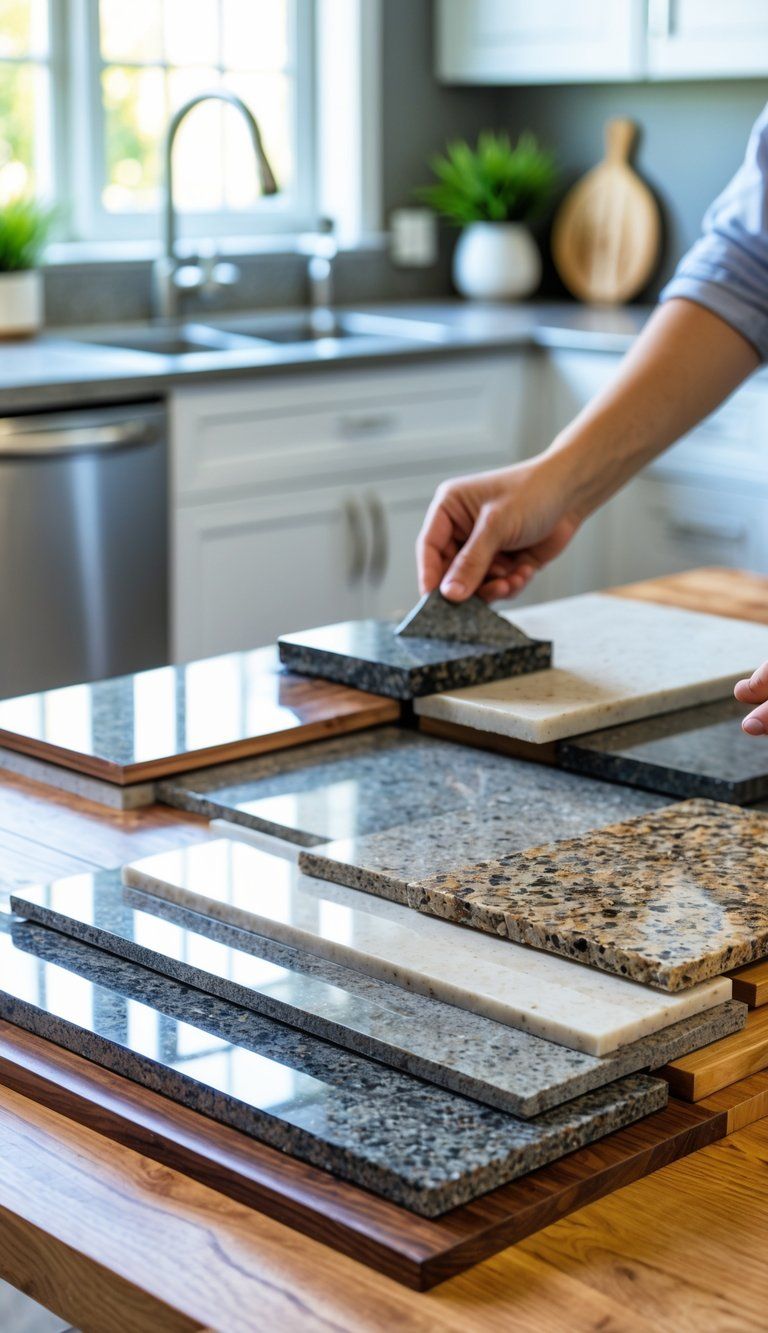
Start by thinking about how you cook and live. If you’re always in the kitchen, heat-resistant choices like granite might just make your life easier than softer surfaces.
Busy households often go for non-porous materials like quartz because they shrug off stains and clean up fast. Wood feels warm and inviting but needs extra care, while marble looks fancy but can get etched pretty easily.
The countertop you pick sets the tone for your kitchen’s overall design and has a big impact on your budget and daily happiness. Materials can run from $40 to $100+ per square foot, so it’s not a small decision.
If you weigh both looks and practicality, you’ll end up with countertops that make your kitchen a better place for years.
Understanding the Practical Roles of Countertops
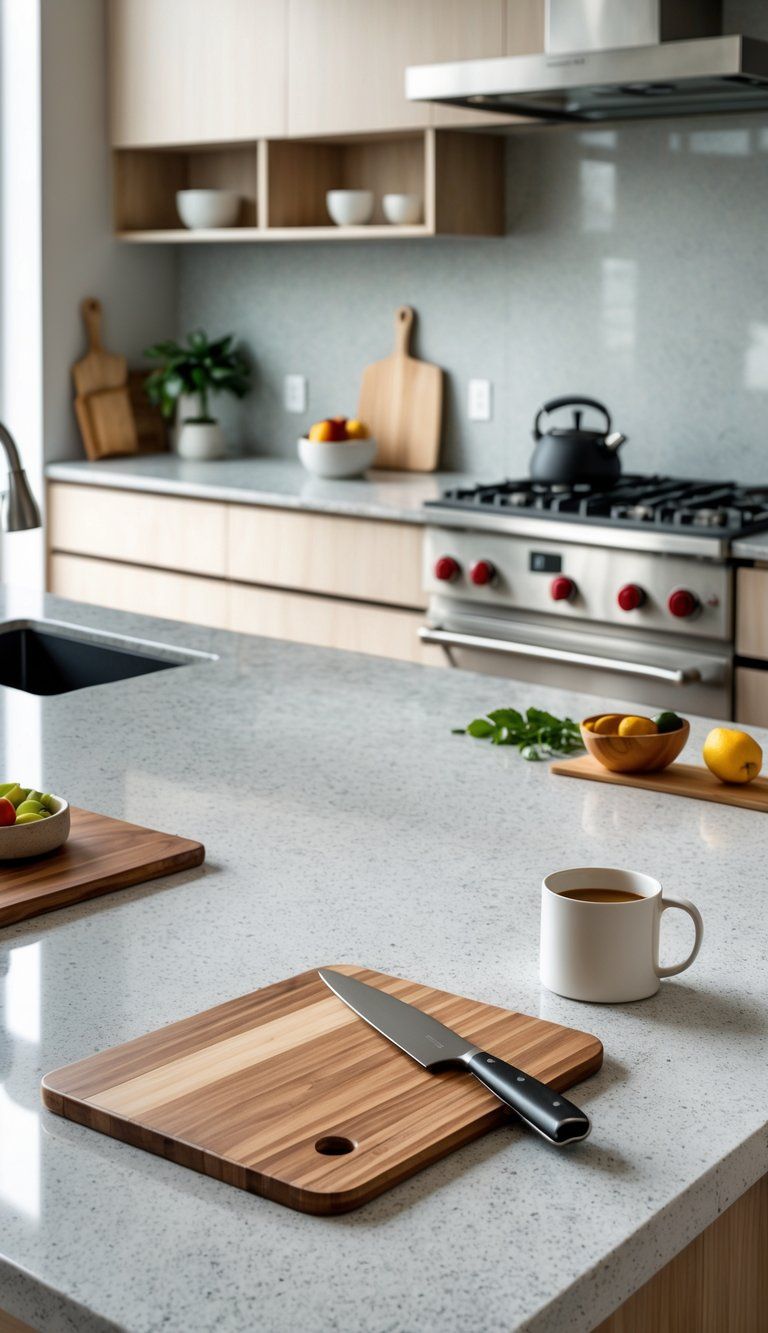
Countertops do a lot more than just look nice. They work hard every day, handling all sorts of tasks and still need to look good and hold up over time.
Everyday Functionality
You use your countertops for just about everything—food prep, cooking, serving, and sometimes even a quick meal. You need enough space to chop, roll out dough, or set up your mixer.
In bathrooms, countertops hold your toiletries and put up with splashes all day. Laundry rooms? They’re great for folding and storing detergents.
Height and depth make a difference. Most countertops are 36 inches tall and about 25-26 inches deep, but you can tweak those numbers to fit your height or habits. Bakers often like a lower section (around 30 inches) for rolling dough.
Think about how you’ll actually use the space. If you love entertaining, maybe you want extra countertop area for serving up food or setting out a buffet.
Durability Requirements
Different rooms ask different things from your countertops. In the kitchen, they take a beating:
- Heavy pots and pans
- Chopping and cutting
- Hot pans
- Spills from acidic foods
- Constant cleaning
Material strength really counts. Granite, quartz, and solid surface materials handle high-traffic areas well. Softer stones like marble develop a patina over time and can show wear faster.
Bathrooms need countertops that handle water more than impacts. Laundry rooms? They need to stand up to detergent spills and heavy machines.
If you have kids, you’ll probably want something that can take a little rough treatment.
Heat and Scratch Resistance
Some countertops handle heat and sharp objects better than others. It’s easy to forget about this until you accidentally scorch or scratch something.
Heat resistance isn’t the same for every material:
- Granite usually shrugs off hot pots.
- Quartz can get damaged above 150°F.
- Laminate might scorch or bubble with direct heat.
- Solid surfaces could crack if you put something super hot on them.
If you tend to cut right on the counter, you’ll want granite or quartzite for knife resistance. Softer stones like marble and soapstone scratch more easily.
Most people use trivets and cutting boards, but let’s be honest—accidents happen. Pick something that matches how you really use your kitchen, not just how you wish you did.
Balancing Aesthetic Appeal with Functionality
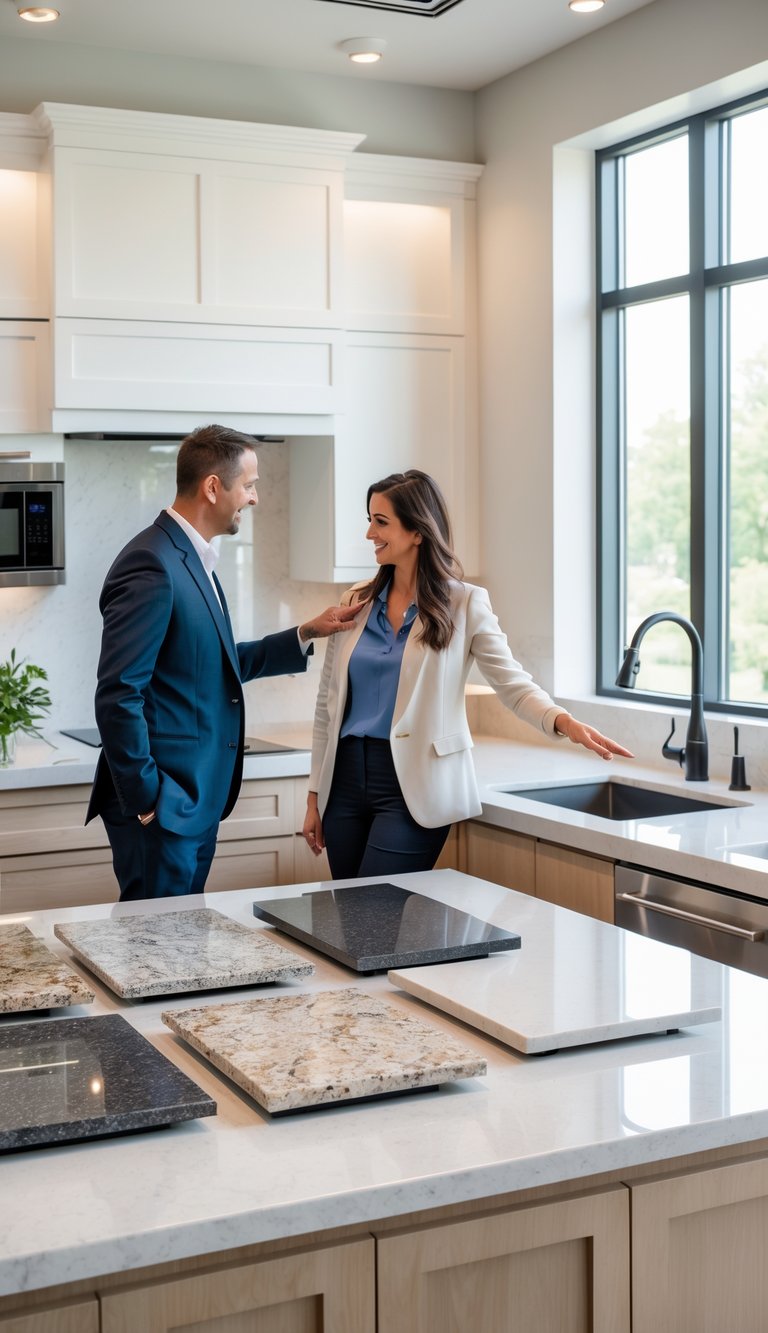
When you’re picking countertops, you can’t ignore how they look—or how they’ll deal with your daily messes. The best countertop feels right for your style and actually works for your life.
Aesthetic Appeal of Countertops
Countertops can totally change your kitchen’s mood. Marble has those dramatic veins and a fancy vibe. Recycled glass countertops bring in splashes of color and a unique, artsy look.
Color plays a big part too. Lighter countertops make small kitchens feel more open, and dark ones can add some drama. Try to picture how your counters will look next to your cabinets and floor.
Texture matters. Polished finishes bounce light and look sleek, while honed or leathered ones feel softer and hide fingerprints better.
Some go-to looks:
- Marble for timeless style
- Granite for natural patterns
- Quartz for that even, modern look
- Butcher block for a cozy, warm vibe
Design Harmony in the Kitchen
Your countertops should play nice with the rest of your kitchen. Modern kitchens usually look great with sleek quartz, while traditional spaces pair well with natural stone.
If your kitchen opens up to the living room, think about how the countertops will flow visually into the next space.
Edge profiles matter too. Straight edges feel modern, while beveled or ogee edges fit classic designs.
Some people use the same material for their backsplash to create visual continuity. It can make a small kitchen feel bigger.
Don’t forget about hardware and lighting—they should work with your countertop choice to pull the whole look together.
Exploring Countertop Materials and Surfaces
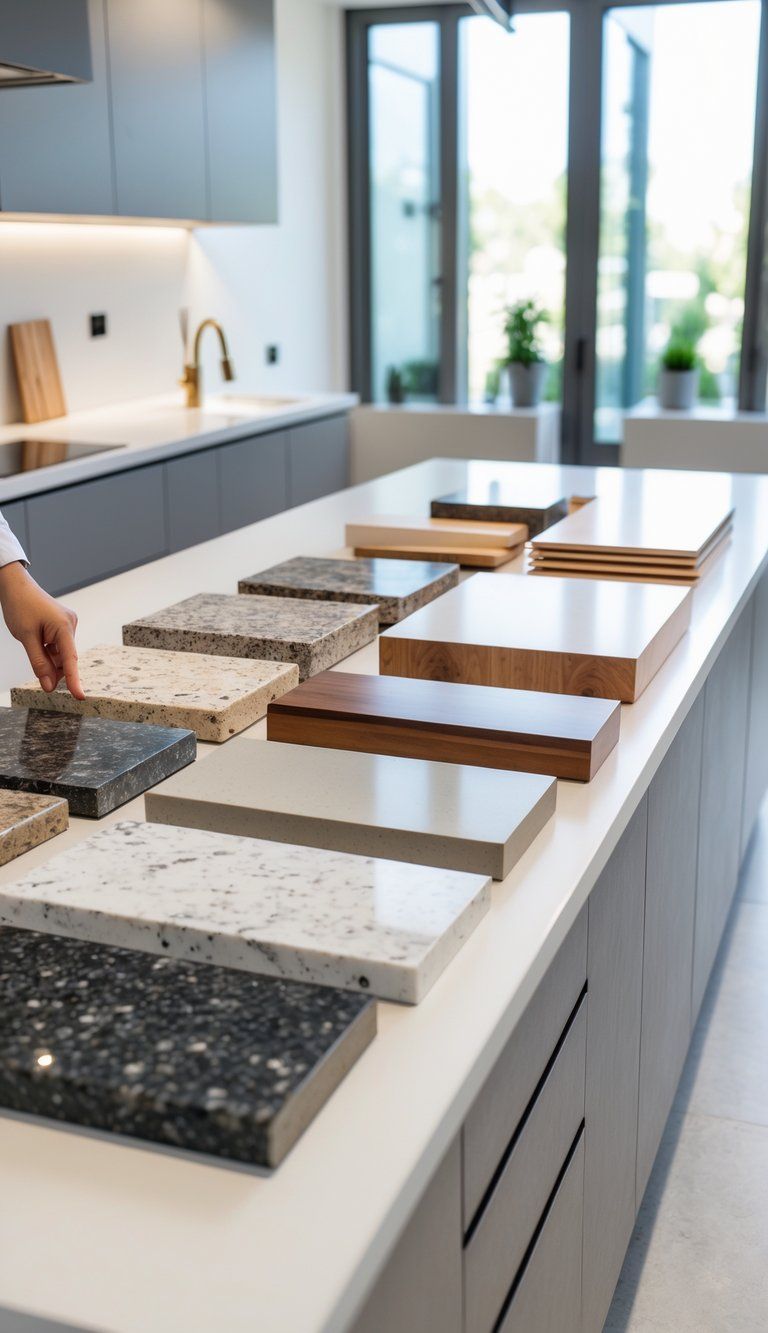
There are more countertop choices now than ever—natural stone, engineered stuff, and eco-friendly options. Each one brings something different to the table for durability, care, and style.
Natural Stone Countertops
Natural stone is still a favorite for kitchens and bathrooms. Granite stands out for durability and heat resistance, perfect if you cook a lot. Every slab looks different, so your kitchen won’t look like anyone else’s.
Marble gives you that classic elegance with cool veining, but it needs regular sealing and can stain or etch if you’re not careful.
Other natural stone options:
- Soapstone: Matte finish, darkens over time—some people love that.
- Quartzite: Looks like marble but tougher.
- Limestone: Warm and earthy, but needs some babying.
All natural stone needs sealing now and then to keep it looking good.
Engineered Materials
Engineered countertops mix natural minerals with resins, usually making them tougher and easier to care for than some natural stones.
Quartz countertops are about 90% crushed quartz with resins and pigments. They’re non-porous, so they resist stains and bacteria and need no sealing. Tons of colors and patterns are available, some that look just like stone.
Solid surface countertops (like Corian) are made from acrylic polymers and minerals. You get seamless sinks and backsplashes, and if you scratch them, they can be repaired or buffed out.
Laminate is the budget pick, but newer versions look way better than the old stuff and hold up surprisingly well.
Sustainable and Recycled Options
Eco-friendly countertops are out there if you want something greener. Recycled glass countertops mix post-consumer glass into cement or resin, so every piece looks unique and colorful.
Butcher block and wood countertops bring warmth, and if you choose sustainable or reclaimed wood, it’s a responsible pick. They need regular oiling but can be sanded down if they get scratched.
Concrete countertops are super customizable, and you can add recycled glass or shells for a one-of-a-kind look. They use less new material if you go the recycled route.
Paperstone and similar composites use recycled paper and non-petroleum resins, making them durable and heat-resistant but easier on the planet.
Assessing Budget and Value Considerations
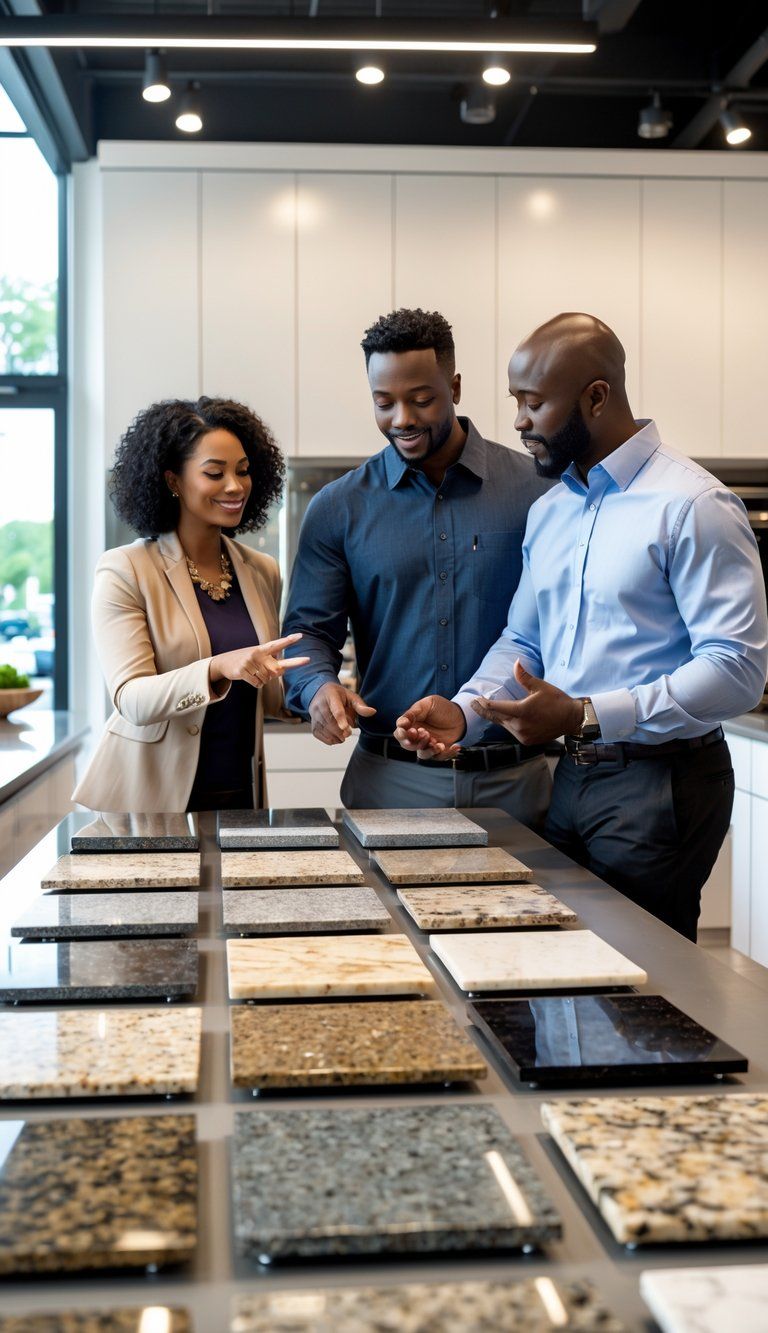
Let’s be real—cost matters. The right countertop fits your budget now and hopefully adds value to your home down the road.
Budget Planning for Countertops
A good rule of thumb: set aside 10-20% of your kitchen remodel budget for countertops. So if you’re spending $20,000 on the kitchen, you might want $2,000-$4,000 for counters.
Here’s what you might spend:
- Laminate: $10-40 per square foot
- Butcher block: $40-100 per square foot
- Granite: $40-100 per square foot
- Quartz: $50-120 per square foot
- Marble: $60-180 per square foot
Installation isn’t free—plan for $300-500 for simple jobs, or $1,000+ if things get complicated.
Shop around. Always get at least three quotes because prices can swing a lot.
Resale and Property Value Impact
Good countertops can bump up your home’s value. Realtors love updated kitchens.
High-end materials like quartz and granite usually give you the best bang for your buck. The National Association of Realtors says you might get back up to 80% of your kitchen remodeling costs when you sell.
Look at what’s normal in your neighborhood. If you live in a mid-range area, going ultra-luxury might not make sense.
Neutral, classic materials tend to attract more buyers than bold trends. Even if you go with something budget-friendly, a well-installed, well-kept countertop always looks better than a pricey one that’s beat up.
Evaluating Maintenance and Longevity
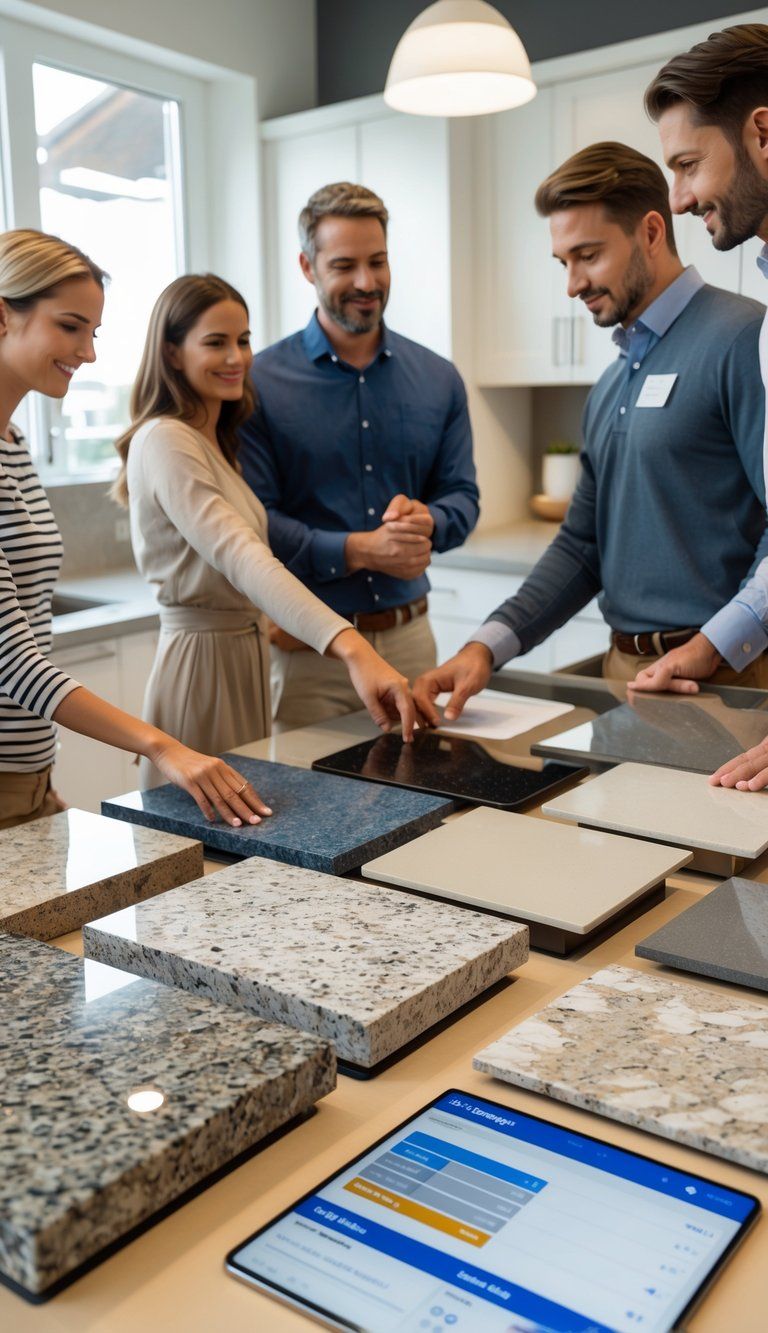
Your countertops will be around for a long time, so you really want to know what it takes to keep them looking good. Every material has its own care routine.
Cleaning and Upkeep
Day-to-day cleaning is usually simple—a damp cloth and mild soap does the trick for most surfaces.
Quartz is super easy. No sealing, not much stains, just a wipe with soapy water. Skip the harsh chemicals, though.
Granite and marble need a bit more love. You’ll want to seal them once or twice a year to keep stains out and use pH-neutral cleaners.
Laminate is low-fuss but doesn’t like heat or sharp stuff. Clean with mild detergent and avoid anything too abrasive.
Maintenance Tips by Material
Granite:
- Seal every 6-12 months
- Wipe spills right away, especially acids
- Use cutting boards to avoid scratches
- Keep hot pots off the surface
Quartz:
- Skip the sealing
- Clean with mild soap and water
- Use trivets for hot pans
- Pretty stain-resistant, but don’t push your luck with heat
Butcher Block:
- Oil every month with food-grade mineral oil
- Sand out scratches if you need to
- Disinfect with vinegar
- Dry well after cleaning to avoid warping
Solid Surface (like Corian):
- Buff out small scratches
- No sealing needed
- Avoid harsh cleaners
- You can get it professionally resurfaced if things get rough
Stay on top of maintenance and your countertops can last 15-20 years or more. If you take care of them, they’ll keep your kitchen looking sharp for a long time.
Integrating Countertops With Kitchen Features
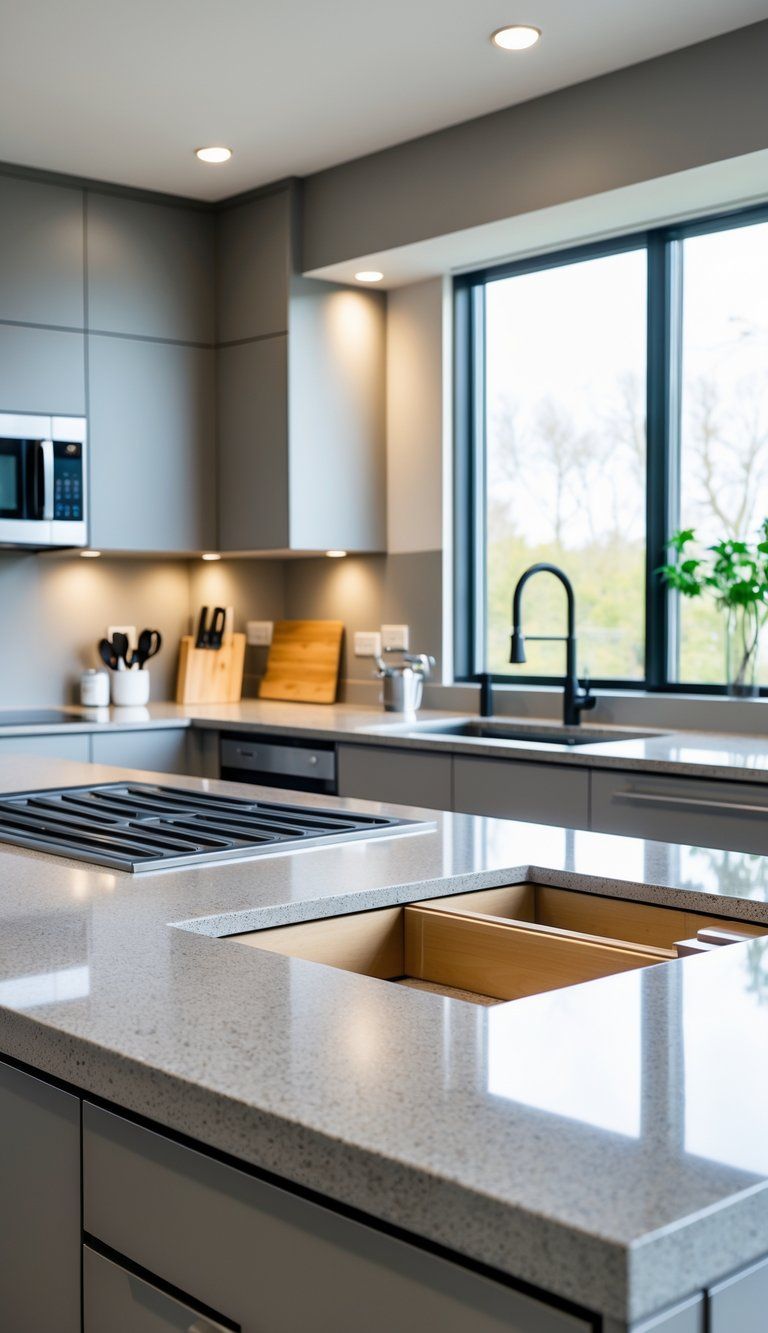
Countertops aren’t just floating in space—they’ve got to play nice with your cabinets, lighting, and flooring if you want a kitchen that feels pulled together.
Cabinetry Pairings
Think about contrast when you match countertops with cabinets. Dark cabinets can really pop with lighter countertops and keep things visually balanced.
White cabinets are kind of a blank canvas. Honestly, they look good with almost any countertop, whether you want bold black granite or a softer beige quartz.
If you’ve got wood cabinets, pay attention to undertones. Cherry wood with red tones pairs nicely with warm-hued counters, while oak or maple with yellow undertones usually look best with cooler countertop colors.
Islands give you a chance to mix things up. Maybe you’ll go for a butcher block island top and quartz everywhere else—practical and a little bit stylish.
Don’t forget about cabinet hardware. Brushed nickel pulls can look sharp with gray countertops, while brass hardware brings out the warmth in golden or brown surfaces.
Lighting Considerations
Lighting really changes how your countertops look—sometimes a lot more than you’d expect. If you can, check samples near a window where you get good daylight.
Under-cabinet lighting helps you see what you’re doing and highlights the details in your counters. LED strips work great for showing off granite or marble textures.
Pendant lights over islands put a spotlight on your counters. Pick fixtures that echo your countertop style and the rest of your kitchen vibe.
Polished quartz or granite countertops reflect light and can make your kitchen feel bigger and brighter.
If you prefer a softer look, matte finishes don’t bounce light around as much. They tend to work well if you already have a lot of natural light coming in.
Flooring Coordination
Floors and countertops shouldn’t match exactly, but they ought to get along. Aim for coordination, not a perfect match.
Hardwood floors go with almost any countertop. The warmth of wood balances out the coolness of stone or quartz.
Tile floors look best when they share some color with your counters. If your granite counters have speckles, try to find tile with similar tones.
Open floor plans mean your kitchen counters will be visible from other rooms. Think about how they’ll look from your living or dining area.
If your floors are bold or patterned, keep your countertops simple. Too many busy patterns can feel overwhelming.
Planning for Countertop Installation
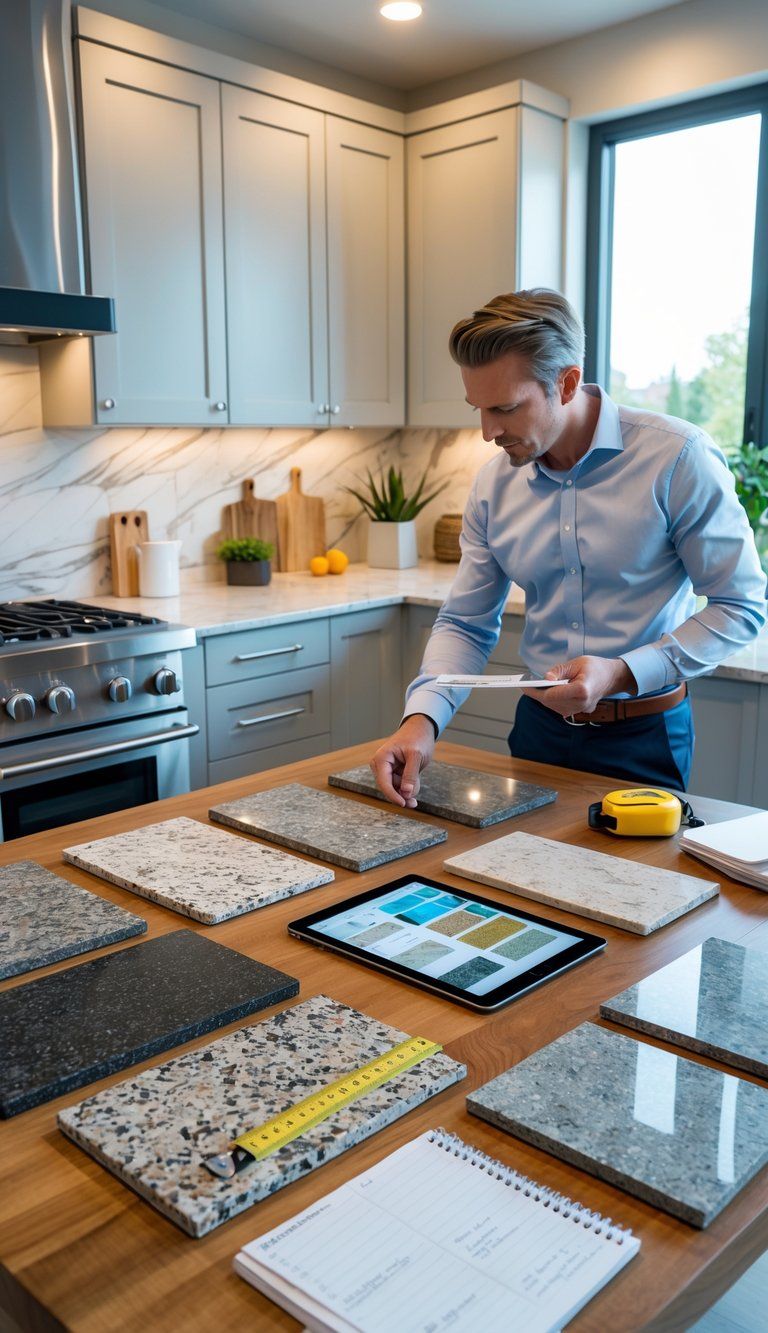
Careful planning makes countertop installation a lot less stressful. If you take time to understand the process and work with the right pros, you’ll probably save money—and maybe your sanity too.
Countertop Installation Steps
Start with accurate measurements. Pros usually make templates, which helps them get the fit right, especially with tricky layouts or cutouts for sinks and appliances.
The whole process, from template to done, usually takes a week or two. The actual installation part? That’s often just two or three days.
Before installation day, clear off your old counters and empty the cabinets underneath. Move any appliances that might get in the way.
Expect dust and noise during the work. You’ll probably be without a functional kitchen for at least a day while adhesives dry.
After the crew finishes, check all the seams, edges, and fixtures. Most installers will seal natural stone and give you some basic care tips.
Selecting an Experienced Designer
A good designer does more than pick pretty colors. They’ll help you balance looks with real-life function based on how you actually use your kitchen.
Look for designers who have:
- Portfolios with projects kind of like yours
- Certifications from industry groups
- At least five years working with countertop materials
- A solid understanding of local building codes
Ask them how they handle weird spaces or tricky layouts. The best designers usually have creative fixes for odd corners or slanted walls.
Meet with a couple of designers in person before you decide. Bring along samples of your cabinets, flooring, and paint colors—makes those meetings more productive.
A good designer will talk about things like maintenance and durability, not just style. They should give you a written estimate that actually breaks down the costs, not just a vague price range.
Conclusion: Making a Confident Countertop Selection
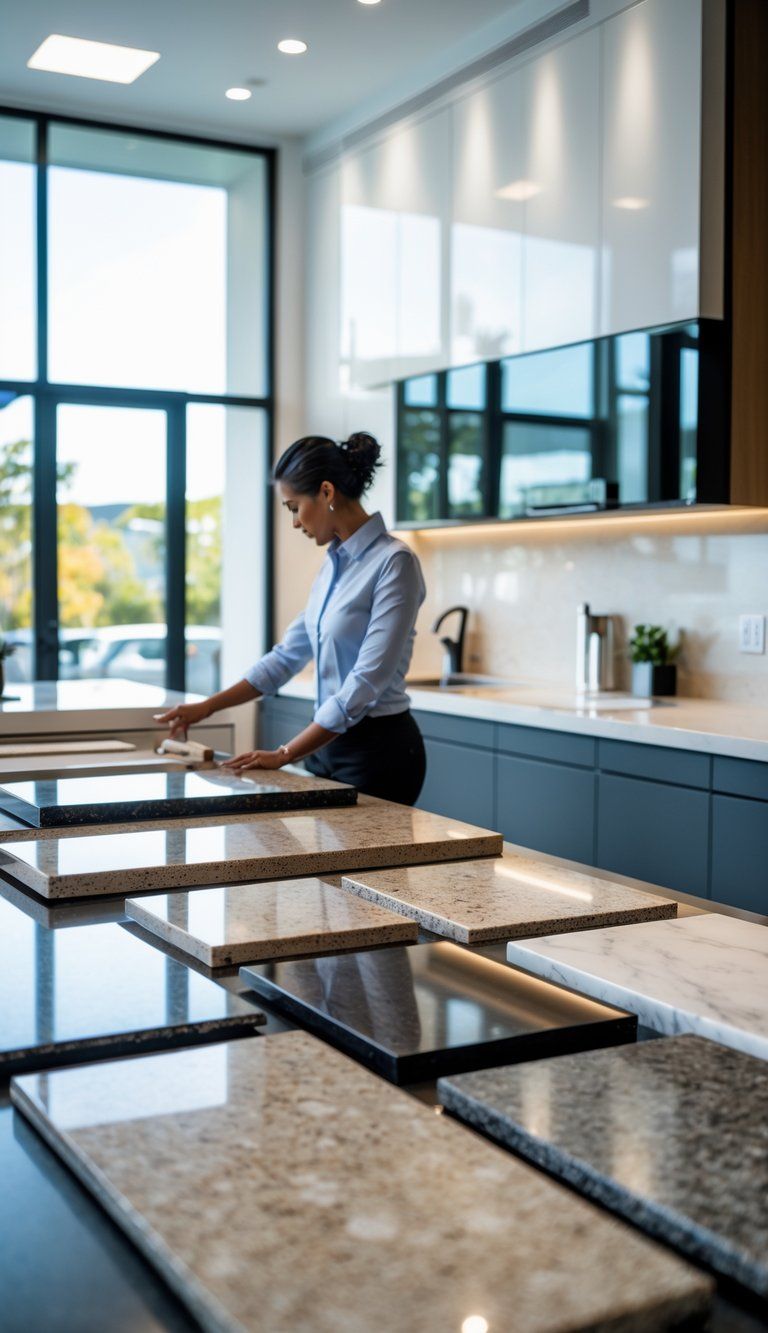
Choosing the right countertop doesn’t have to feel overwhelming. If you balance looks with practicality, you’ll probably find something that works for you for years.
Start by figuring out what matters most. Do you want something super durable, easy to clean, or just gorgeous to look at? Your lifestyle really ought to steer the decision.
Key things to keep in mind:
- How you’ll use the countertop every day
- How much maintenance you can handle
- Your budget
- What styles you actually like
- Whether it’ll last over time
Talk to some pros if you can. They often spot details about materials that you’d probably miss just scrolling online.
Try to see samples in person. Sometimes, what looks amazing in a photo just doesn’t match your cabinets or floors once you see it at home.
Take your time with the decision. Weigh the pros and cons for your own situation.
The countertop that’s “perfect” is really just the one that fits your life. What looks stunning in a showroom might not stand up to your busy kitchen.
Trust your gut, but keep the practical stuff in mind too. If you do a bit of research and think it through, you’ll end up with something that makes your kitchen both beautiful and useful for a long time.

